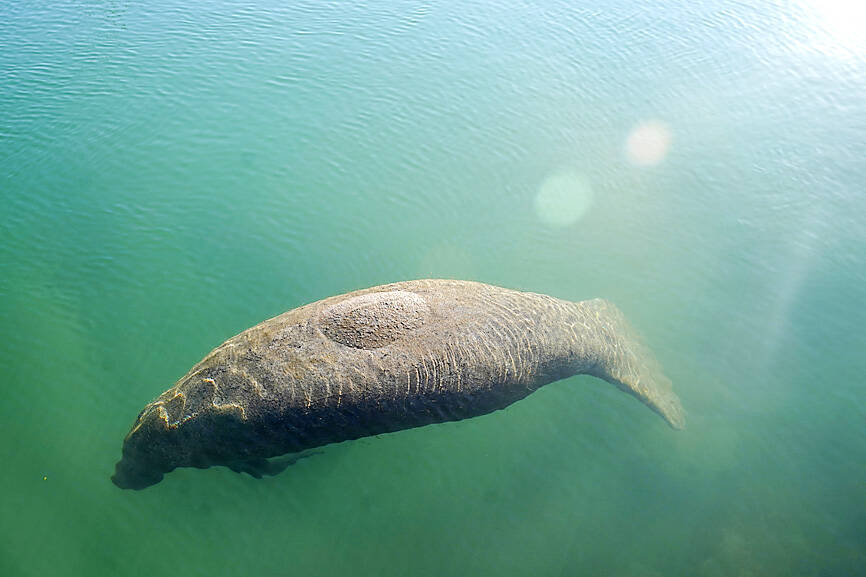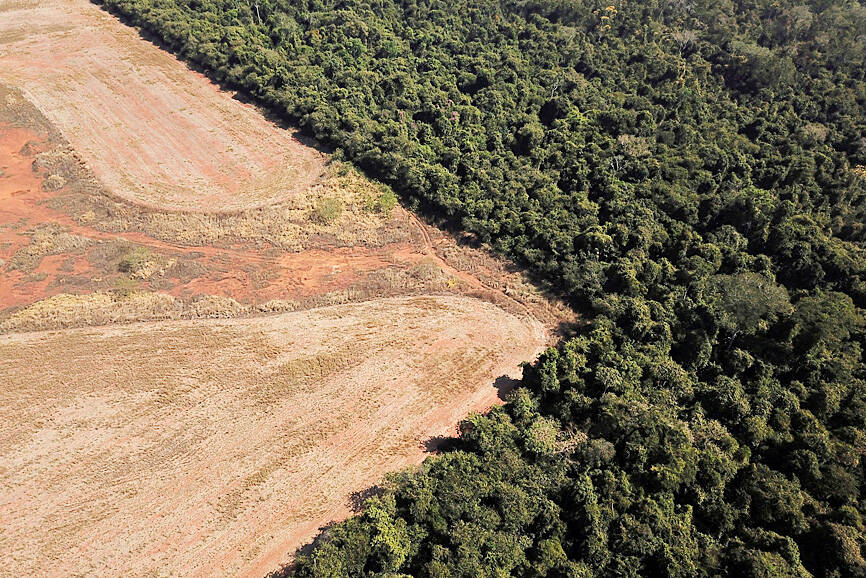In the rivers of the Peruvian Amazon, manatees wallow in the murky water, making them very hard to spot.
If you are lucky, you might see their nostrils poking out above the surface, British ecologist Kat Bruce said.
A few years ago, she joined conservationists from the WWF who were traveling a 1,000-km stretch of river to study manatees and other species.

Photo: AP
“You basically can’t survey them apart from by going to communities and asking if they’ve seen any manatees recently,” said Bruce, who in 2014 set up a monitoring company called NatureMetrics Ltd.
However, the aim of this trip was not a rare sighting. Instead, the researchers were taking water samples.
NatureMetrics pushes the water through a filter to collect traces of DNA, which are analyzed in a lab to understand which species are active in the area — in the water and on nearby land.

Photo: Reuters
In Peru, they found 675 vertebrate species — from manatees and river dolphins to night monkeys living high in the trees.
As countries negotiate a global pact to halt and reverse nature loss at the COP15 summit in Montreal this month, researchers and companies such as NatureMetrics hope their new technologies can help track progress on protecting biodiversity more accurately than ever before.
They are in a race against time, as up to 1 million of Earth’s estimated 8 million plant, insect and animal species are at risk of extinction, many within decades, an international scientific report showed in 2019.
On Friday, the International Union for Conservation of Nature (IUCN) released an update to its Red List of endangered species, flagging a “barrage of threats” affecting marine wildlife, including illegal fishing, pollution and climate change.
While success in curbing global warming can be measured in terms of reductions in planet-heating greenhouse gas emissions, understanding what advances in biodiversity protection mean for governments and companies tends to be more complex.
“You can’t actually measure ecosystem health just by monitoring what you can see,” NatureMetrics CEO Katie Critchlow said.
Using environmental DNA, or “eDNA”, NatureMetrics says it can gather more biodiversity data far faster than traditional surveys, including the presence of IUCN Red List species.
This can be tracked by small DNA filters. Water from an ecosystem is pushed by a syringe through the small discs, which are then sent to specialist labs in the UK and Canada, much like DNA tests to find out people’s ancestry.
NatureMetrics, which has grown to more than 140 employees, serves non-governmental organizations (NGOs) and companies that are looking to monitor progress in restoring a degraded ecosystem or measure whether development projects such as mining are causing harm.
“All of a sudden, now you can know whether things are getting better or not — and that’s just not been possible before,” Critchlow said. “We feel that this is quite revolutionary.”
The eDNA method is just one of a number of innovative new techniques, said Karl Burkart, co-founder and deputy director of US-based nonprofit One Earth, which is working to scale up biodiversity mapping technologies.
“In the next three to five years, we’re going to have a lot of breakthroughs in direct observation measuring,” he said.
For example, tiny cameras have been trained with artificial intelligence to collect and interpret what they capture in the field, such as detecting humans and animal species.
TrailGuard AI, created by the NGO Resolve and chipmaker Intel Corp, is developing this technology to create an alert system against animal poachers in Africa.
Another approach is acoustic sensors, which can monitor sounds from species such as birds and even insects, and is an “incredibly effective” way of determining the overall health of an ecosystem, Burkart said.
Some forests might look good from satellite images, but inside, their biodiversity can be severely degraded, a phenomenon known as “zombie forests,” he said. “It looks good from space, and inside it’s deathly silent.”
Burkart added that a “mesh” of these techniques together with remote sensing technology, deployed on planes and satellites, can provide a fuller picture of an ecosystem and how its complex parts interact.
One leader in remote sensing technologies is Arizona State University, whose scientists have created a method called “spectranomics,” whereby images taken from the air can show the complexity of species.
Used across the Andes and Amazon regions, advanced sensors can detect the unique chemical signatures of tree species based on how they interact with sunlight and illustrate the results in colorful maps.
Greg Asner, director of the school’s Center for Global Discovery and Conservation Science, said the approach, which he codeveloped, can help improve protection of tropical forests beyond broad strategic plans.
“Monitoring changes to the composition of those forests helps us to inject specific actions to save what is most unique, or what is different in one forest from another,” he said.
As these solutions begin to make their way from scientific papers to equipment used on the front lines of the natural world, investors are taking biodiversity more seriously — and could help expand the techniques for use by businesses, Burkart said.
A World Economic Forum report in 2020 showed that more than half of the world’s total GDP is dependent on nature and its services, meaning that nature loss poses a significant risk to global economic health.

The US dollar was trading at NT$29.7 at 10am today on the Taipei Foreign Exchange, as the New Taiwan dollar gained NT$1.364 from the previous close last week. The NT dollar continued to rise today, after surging 3.07 percent on Friday. After opening at NT$30.91, the NT dollar gained more than NT$1 in just 15 minutes, briefly passing the NT$30 mark. Before the US Department of the Treasury's semi-annual currency report came out, expectations that the NT dollar would keep rising were already building. The NT dollar on Friday closed at NT$31.064, up by NT$0.953 — a 3.07 percent single-day gain. Today,

‘SHORT TERM’: The local currency would likely remain strong in the near term, driven by anticipated US trade pressure, capital inflows and expectations of a US Fed rate cut The US dollar is expected to fall below NT$30 in the near term, as traders anticipate increased pressure from Washington for Taiwan to allow the New Taiwan dollar to appreciate, Cathay United Bank (國泰世華銀行) chief economist Lin Chi-chao (林啟超) said. Following a sharp drop in the greenback against the NT dollar on Friday, Lin told the Central News Agency that the local currency is likely to remain strong in the short term, driven in part by market psychology surrounding anticipated US policy pressure. On Friday, the US dollar fell NT$0.953, or 3.07 percent, closing at NT$31.064 — its lowest level since Jan.

The New Taiwan dollar and Taiwanese stocks surged on signs that trade tensions between the world’s top two economies might start easing and as US tech earnings boosted the outlook of the nation’s semiconductor exports. The NT dollar strengthened as much as 3.8 percent versus the US dollar to 30.815, the biggest intraday gain since January 2011, closing at NT$31.064. The benchmark TAIEX jumped 2.73 percent to outperform the region’s equity gauges. Outlook for global trade improved after China said it is assessing possible trade talks with the US, providing a boost for the nation’s currency and shares. As the NT dollar

The Financial Supervisory Commission (FSC) yesterday met with some of the nation’s largest insurance companies as a skyrocketing New Taiwan dollar piles pressure on their hundreds of billions of dollars in US bond investments. The commission has asked some life insurance firms, among the biggest Asian holders of US debt, to discuss how the rapidly strengthening NT dollar has impacted their operations, people familiar with the matter said. The meeting took place as the NT dollar jumped as much as 5 percent yesterday, its biggest intraday gain in more than three decades. The local currency surged as exporters rushed to